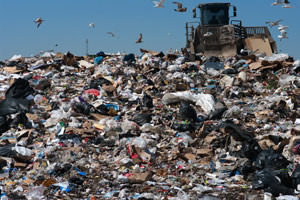
Environment
 Did you know that there are close to 25,000,000 mattresses and 25,000,000 box springs manufactured in the United States each year?
Did you know that there are close to 25,000,000 mattresses and 25,000,000 box springs manufactured in the United States each year?
Of those, 70% are purchased to replace an old unit with 25% of the replaced units being discarded. The bottom line, close to 4,500,000 mattresses and 4,500,000 box springs are destined for the landfill or incinerator each and every year in the U.S. That amounts to over 250,000,000 pounds of mattresses alone!
Whether it's a major mattress swap out at a college, hotel or military dormitory or the ongoing piles that are collected at retailers, transfer stations and landfills across our country, the massive volume of mattresses and box springs is astounding.
Why burn or bury all that material in the ground when it can be recycled instead?
The truth about landfills is that waste, once-dumped, compacted and buried, becomes entombed. It does not degrade or disappear over time. It just sits there. And if the landfill is old and/or poorly designed, the waste may partially degrade and allow contamination to leach into the ground polluting the surrounding environment and aquifers.
When it comes to mattresses and landfills, the story is even more troubling:
Click Here to Read our Mattresses and Landfills Study
As the study shows, landfilling mattresses results in:
- Lost Landfill Revenue
- Shortened Landfill Lifespan, requiring new landfills to built
- Major Operational Issues
- Failure to meet recycling rules and regulations.
Recycling on the other hand ensures that the material is processed and put back to a higher use for years to come.
There are several environmental benefits due to recycling:
- Extended landfill life
- Reduced pollution associated with extraction of virgin materials, e.g. pulpwood
- Spared resources for future use
One of the principal reasons Americans recycle is because America's landfills are filling up at a rate of about 100 million tons per year and it is extremely hard to site new ones due to the "Not In My Backyard" (NIMBY) syndrome. Diverting trash from landfill disposal through recycling efforts does prolong the life of existing landfills and delay the need to open new ones.
One way of estimating the environmental benefits of recycling is to calculate the reduction in energy required to manufacture products using recycled feedstock compared to virgin feedstock. Since energy production has significant environmental impacts, reduction in energy needed translates into environmental benefits, including reduced pollution. A report from the Natural Resources Defense Council points out that since energy use causes a large part of the total environmental impact engendered by virgin material based-production, the lower energy use of production facilities employing recycled materials suggests that they emit fewer pollutants, including greenhouse gases.
According to NRDC, here are some of the reductions potentially available by using recycled materials to make things:
| Product | Reduction in Energy Needed |
| Aluminium | 94% |
| Plastic (3 grades) | 70-80% |
| Steel | 60% |
| Newsprint | 40% |
| Glass | 40% |
| Linerboard | 20% |
According to these figures, recycling metals and plastics, i.e. mattress and box springs and padding, has significant environmental impact.
For all of these reasons, recycling your mattresses and box springs makes environmental sense. Combined with the very real cost savings, recycling with Nationwide Mattress Recycling adds up to a Win, Win!
Customer Satisfaction
To ensure customer satisfaction, Nationwide Mattress Recycling sends a Field Representative to each job site to confirm that the mattress and box spring removal and loading is proceeding smoothly.
The Field Representative also performs a basic inspection of the items being placed in our truck or trailer. This enables us, based upon the type and size of the items on board, to send the material to the appropriate Nationwide Mattress Recycling destination facility for reprocessing and recycling.

